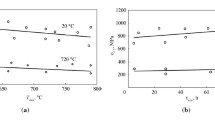Abstract
The high damping properties of ferrite chromium steels caused by magnetoelastic hysteresis depend substantially on the defects of the crystal structure. For this reason the regimes of mechanical and heat treatment can change their damping level by more than a factor of 10. Elimination of thermal stresses and deformations in parts, prevention of formation of carbides, intermetallic compounds or chemical inhomogeneities in the structure of steels, and the reduction of the specific surface of the boundaries are known, but still insufficiently studied, ways of attaining a highly damped state in steels and alloys. The present work concerns the effect of the mentioned factors and some others on the damping properties of a ferrite steel of grade 01 Kh6F2. Another object of study is the effect of a variable magnetic field on the damping and the defect of the shear modulus. The results obtained are analyzed to interpret the regular features established.
Similar content being viewed by others
References
I. B. Kekalo, “Magnetoelastic phenomena,” in:Itogi Nauki Tekhn., Ser. Metalloved. Term. Obrab., Vol. 7 [in Russian], VINITI, Moscow (1973).
M. S. Blanter, I. S. Golovin, S. A. Golovin, et al.,Mechanical Spectroscopy of Metallic Materials [in Russian], Izd. Mezhdunar. Inzhener. Akademii, Moscow (1994).
K. A. Lanskaya,High-Chromium High-Temperature Steels [in Russian], Metallurgiya, Moscow (1976).
I. S. Golovin and N. Ya. Rokhmanov, “To the problem of the mechanism of formation of a damped state in high-chromium ferritic steels,”Metalloved. Term. Obrab. Met., No. 9, 29–34 (1993).
I. S. Golovin and I. A. Varvus, “Effect of temperature on the damping capacity of high-chromium ferritic steel,”Metalloved. Term. Obrab. Met., No. 1, 26–30 (1994).
B. A. Potekhin and E. V. Derevyankin, “Damping properties of Fe−Cr−Al steels and their use,” in:Abstr. 6th Republican Sci.-Eng. Conf. “Damping Metallic Materials,” [in Russian], Kirov (1991), pp. 79–82.
A. P. Nichipuruk, B. A. Potekhin, E. G. Gerasimov, et al., “Decrement of damping of mechanical vibrations and magnetic properties of iron and Fe−Cr and Fe−Cr−V alloys,”Fiz Met. Metalloved.,80(1), 49–53 (1995).
B. A. Potekhin, M. Yu. Belyaev, and A. B. Potekhin, “Effect of a magnetic field on the damping of ferrite steels,” in:Damping Materials, Mater. 7th Russian Sci.-Eng. Conf., [in Russian], Kirov (1994), pp. 37–40.
Author information
Authors and Affiliations
Additional information
Translated from Metallovedenie i Termicheskaya Obrabotka Metallov, No. 12, pp. 6–9, December, 1997.
Rights and permissions
About this article
Cite this article
Potekhin, B.A., Potekhin, A.B. Effect of the heat-treatment regime and carbon content on the damping properties of steel 01Kh6F2. Met Sci Heat Treat 39, 504–507 (1997). https://doi.org/10.1007/BF02471367
Issue Date:
DOI: https://doi.org/10.1007/BF02471367




